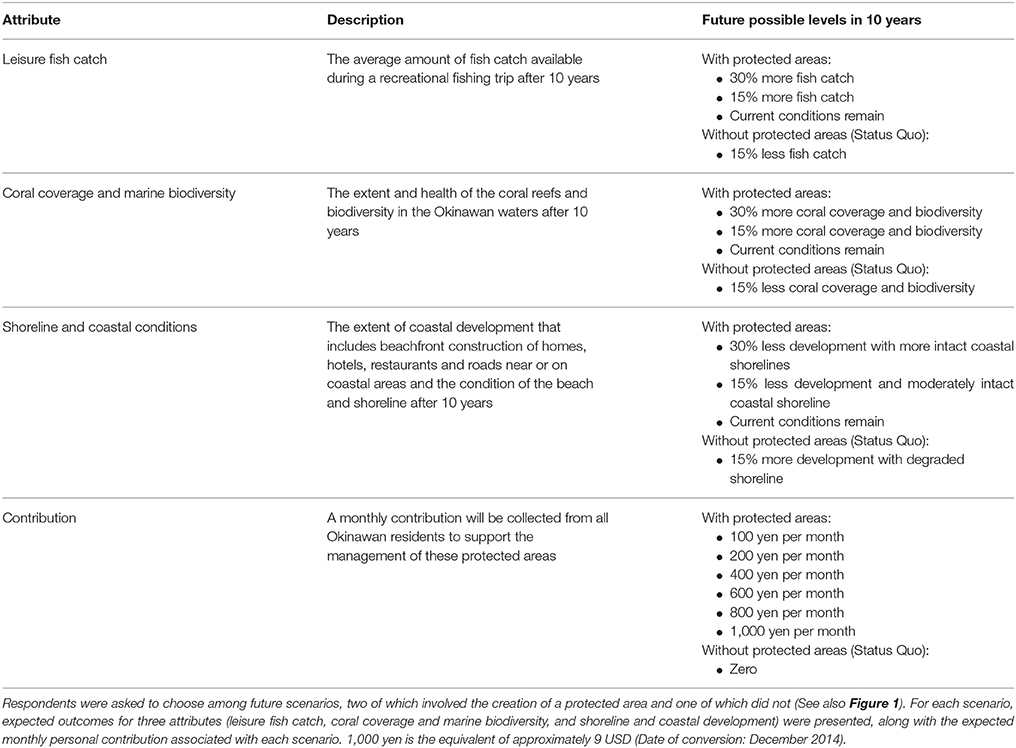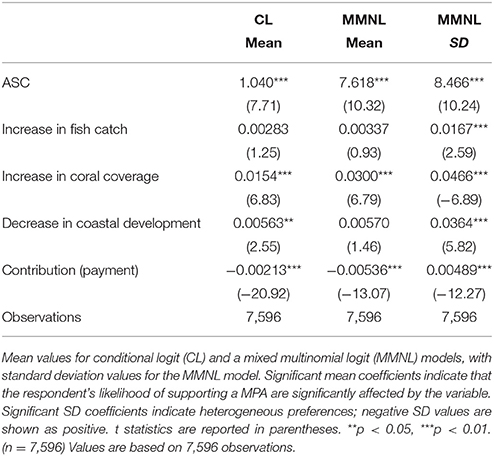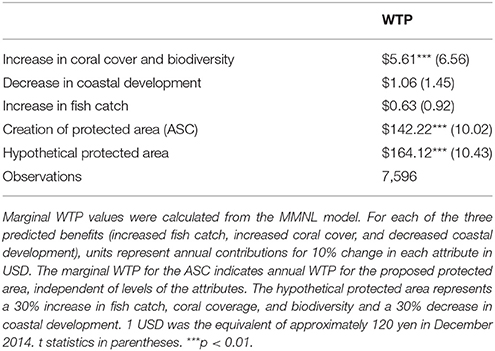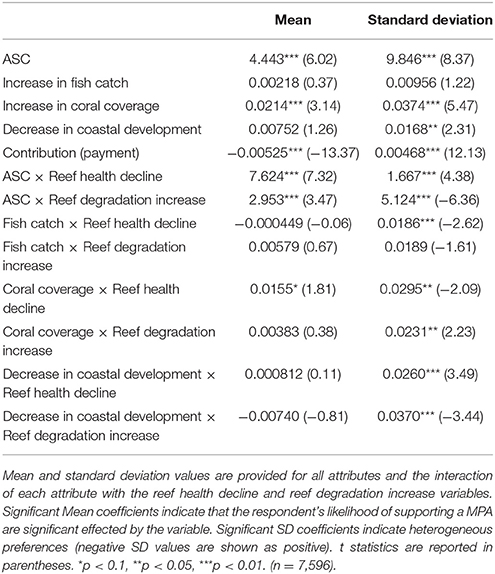- 1Environmental Studies Program, Colby College, Waterville, ME, United States
- 2Department of Economics, Colby College, Waterville, ME, United States
- 3Okinawa Institute of Science and Technology, Okinawa, Japan
- 4Department of Economics, Portland State University, Portland, OR, United States
A loss of memory of past environmental degradation has resulted in shifted baselines, which may result in conservation and restoration goals that are less ambitious than if stakeholders had a full knowledge of ecosystem potential. However, the link between perception of baseline states and support for conservation planning has not been tested empirically. Here, we investigate how perceptions of change in coral reef ecosystems affect stakeholders' willingness to pay (WTP) for the establishment of protected areas. Coral reefs are experiencing rapid, global change that is observable by the public, and therefore provide an ideal ecosystem to test links between beliefs about baseline states and willingness to support conservation. Our survey respondents perceived change to coral reef communities across six variables: coral abundance, fish abundance, fish diversity, fish size, sedimentation, and water pollution. Respondants who accurately perceived declines in reef health had significantly higher WTP for protected areas (US $256.80 vs. $102.50 per year), suggesting that shifted baselines may reduce engagement with conservation efforts. If WTP translates to engagement, this suggests that goals for restoration and recovery are likely to be more ambitious if the public is aware of long term change. Therefore, communicating the scope and depth of environmental problems is essential in engaging the public in conservation.
Introduction
A loss of memory of past environmental degradation has resulted in “shifted baselines” or a reduction in expectations for the natural environment over time (Pauly, 1995). In this context, baseline is defined as a person's view of the natural state of the world, shifted baselines are views that fail to perceive past change, and historical baselines are a past states with less human impact as compared to the current state. Shifted baselines have been demonstrated among resource users such as fishers, with younger generations identifying less change than their elders across a range of metrics (Saenz Arroyo et al., 2005). However, the degree to which the general public exhibits the shifting baseline syndrome is unclear, or to what extent perception of past environmental change affects engagement with and support for conservation efforts. If stakeholders view past ecosystems as more productive and diverse, it is expected they should support more ambitious conservation efforts, as a limited knowledge of ecosystem potential should also limit interest in improvement over the current state (McClenachan et al., 2012). However, the link between shifting baselines and willingness to support conservation planning has not been directly tested empirically.
Likewise, conservation scientists and practitioners are divided about whether the public is more effectively engaged by optimistic or pessimistic messaging (e.g., Jefferson et al., 2015). While good news stories give the public a sense of hope, there is concern that if problems are not understood, the urgency of action will be underestimated (Jacquet et al., 2015). In particular, for conservation tools that require extensive public input and support, like the implementation of protected areas, understanding drivers of public engagement is essential (Charles and Wilson, 2009). Therefore, quantifying the relationship between views of change and interest in conservation is important to improve communication between conservation practitioners and the public.
While there are many factors that contribute to conservation engagement, one simple metric of understanding support for conservation is willingness to pay (WTP) obtained from stated preferences studies. Typically these studies focused on valuing an environmental good or policy directly. There is a growing literature in non-market valuation that has focused on subjective status-quo beliefs and how perceptions of environmental quality can impact WTP for environmental policies (Whitehead, 2006; Meyerhoff and Liebe, 2009; Domínguez-Torreiro and Soliño, 2011; Marsh et al., 2011; Kataria et al., 2012; Artell et al., 2013). While this approach has shown WTP to be a function of perception of current environmental status, it has not been used to directly test how perception of change over time, or baseline shifts, impacts WTP for conservation. Here, we focus on how beliefs about past environmental change impact WTP for coral reef conservation, which has implication for understanding how shifting baselines impact conservation engagement.
Coral reefs present a particularly good ecosystem to investigate how shifting baselines affect conservation, because coral reef degradation has been widespread, occurring globally in tropical areas (Hoegh-Guldberg et al., 2007; Knowlton and Jackson, 2008). Major changes include coral bleaching and loss of structural habitat (Hoegh-Guldberg, 1999), declines in the size of reef fish (McClenachan, 2009), and increased sedimentation associated with coastal development (Munday, 2004). Such changes have been reported extensively by international media (e.g., Mooney, 2017), are occurring rapidly, and can be observed by residents and visitors to areas where shallow-water coral ecosystems exist (Marshal et al., 2012). Changes to coral reefs are perhaps the most well publicized of any marine ecosystem, but it is unclear to what extent the general public understands the components of degradation and subsequently how perceptions of change translate into engagement with conservation.
Our research addresses the broad question: Are stakeholders who view the environment as degraded when compared to a past state WTP more or less for conservation than those who view the current state as normal? In order to understand how public perception of environmental change affects WTP for conservation, we first investigate how the public views change in coral reef ecosystems across a suite of components of reef health and degradation. Second, we determine whether perception of change affects their WTP for conservation of these ecosystems. Our results find empirical evidence that shifted baselines, or failure to perceive past environmental change, impact WTP for conservation. Specifically, we identify a reduced interest in conservation associated with a shifted baseline, which suggests that communication of environmental problems that have occurred is important to engage the public with conservation planning.
Methods
Background and Study Location
We used a survey and choice experiment focused on understanding how residents view change and their preferences for marine protected areas (MPAs) in Okinawa, Japan. In response to coastal development that has had observed effects on the marine environment, the Japanese Ministry of Environment, the Okinawan Prefectural Government, and local fishing communities have recently implemented several MPAs (Nishihira, 1987; Omori, 2011). These include two MPAs in Kabira Bay and Nagura Bay and a marine special area in Sakiyama Bay, designated as protected in 2010. There are proposals to expand the network of MPAs in Okinawa, with ongoing public discussion in this region. Therefore, understanding how beliefs about ecosystem change affects willingness to support the creation of MPAs can provide useful information to both researchers and policy makers working on creating MPAs in Okinawa, and elsewhere in the world.
Ecosystem Change and Shifted Baselines
We measured respondents' perception of ecosystem change across seven components of coral reef health and degradation: coral abundance, fish abundance, fish diversity, fish size, sedimentation, water pollution, and algal growth. Respondents were asked to report the degree of change they had observed over the past 10 years as (1) Increased significantly, (2) Increased, (3) Did not change, (4) Decreased, or (5) Decreased significantly. From the responses to these seven questions, we created two binary variables to evaluate whether respondents perceived changes to the reef environment over the past decade. The first variable included the four components associated with a functioning reef (coral abundance, fish abundance, fish diversity, fish size). This “reef health decline” variable was equal to 1 if respondents reported at least one of four attributes as having decreased significantly or at least two as having decreased, and did not report that any of the other four variables as increased. It was equal to 0 otherwise. The second variable evaluated perception of change across the three components associated with reef degradation (sedimentation, water pollution, and algal growth). This “reef degradation increase” variable was equal to 1 if respondents reported at least one of the three attributes as having increased significantly or at least two as having increased, and did not report that any of the three variables decreased. It was equal to 0 otherwise. Finally, we compared respondents in these two groups with respect to their WTP to support protected areas, and their WTP for each of the three attributes and for the hypothetical protected area described below.
Choice Experiment Survey and Willingness to Pay for Conservation
Choice experiment surveys are used to understand preferences and elicit values for environmental goods and policies (Carson and Louviere, 2011). Respondents make choices among goods or policies where the characteristics or the values of the attributes are systematically changed, which allows inference of the attributes most important for people's choices, and to estimate their willingness to pay (WTP) for changes in attributes (Hanley et al., 2009).
Our choice experiment provided respondents with seven scorecards, each of which presented a choice among three possible future scenarios associated with the marine environment (Figure 1, Table 1). Two of these future scenarios had protected areas, including both in-water marine protected areas where fishing is prohibited and restrictions on coastal development. The third scenario, which represents the status quo, described outcomes without a MPA and restrictions on coastal development. We identified desired outcomes (or attributes) of protected areas through multiple focus groups and discussions with local researchers. The outcomes included in the survey are: (1) increased recreational fish catch, (2) increased coral cover and marine biodiversity, (3) decreased shoreline and coastal development. Respondents were presented with quantitative scenarios for each of these outcomes 10 years into the future, representing 15 or 30 percent increases in recreational fish catch, coral coverage, and marine biodiversity and 15 or 30 decreases of coastal development (Figure 1, Table 1). The status quo scenario, without protected areas, was described as leading to a 15% decrease in recreational fish catch, coral coverage, and marine biodiversity and a 15% increase in coastal development. Each scenario was associated with a different financial contribution, which allowed us to calculate WTP for each attribute.
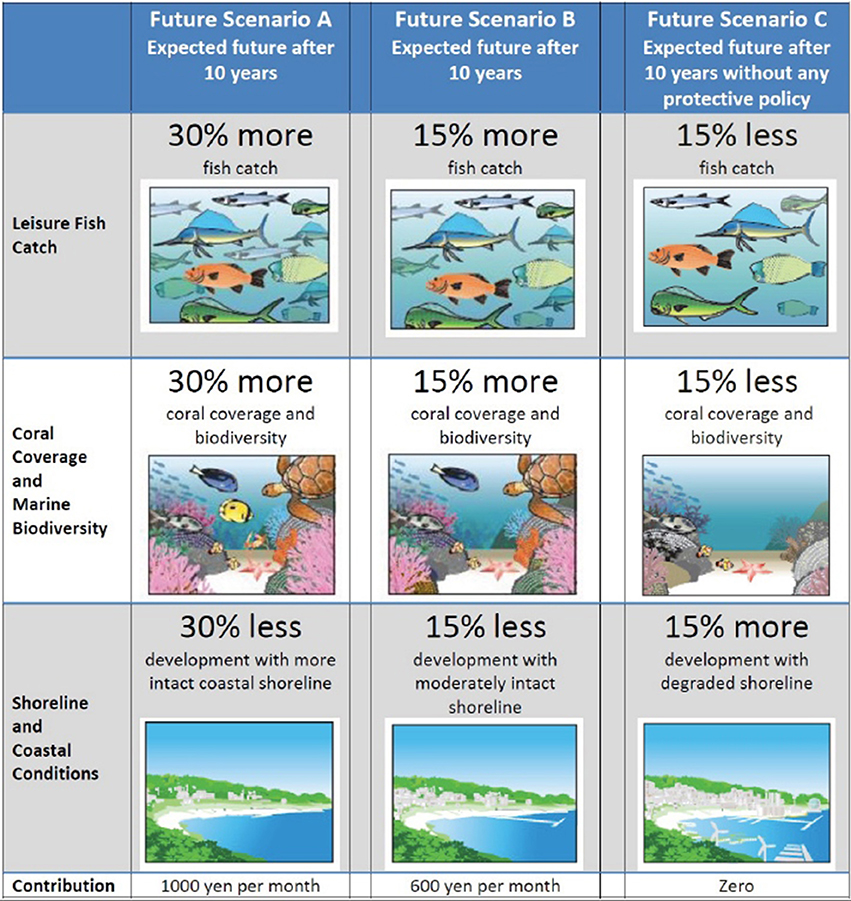
Figure 1. Choice experiment survey example question. Respondents were asked to choose among three future scenarios, two of which involved the creation of a protected area (A,B) and one of which did not (C). For each scenario, expected outcomes for three attributes (leisure fish catch, coral coverage and marine biodiversity, and shoreline and coastal development) were presented, along with the expected monthly personal contribution associated with each scenario.
We followed the standard practice in choice experiment design and used an orthogonal fractional factorial experiment design to select a combination of levels for each attribute and to group them into hypothetical scenarios (Adamowicz et al., 1997, 1998; Louviere et al., 2000). The design for the choice experiments was generated using the SAS macro (Kuhfeld, 2010) and resulted in 81 unique choice questions. Additionally, we asked demographic questions to better understand the factors that may or may not affect choices for specific outcomes. The final survey instrument was administered online during December 2014 and January 2015 to residents of Okinawa using a local professional survey company. The research followed IRB protocols and received approval to conduct the study from the Okinawa Institute of Science and Technology.
We analyzed the choice experiment data using conditional logit (CL) and a mixed multinomial logit (MMNL) models. The CL model, the original statistical model used to analyze discrete choice data from choice experiments, assumes independence from irrelevant alternatives, or that the relative probability of an alternative is not affected by an introduction or an elimination of other alternatives (Hensher et al., 2005; Birol et al., 2006). It also assumes the homogeneity of the preferences of respondents and therefore only provides a mean estimate across the sample for each attribute (Birol et al., 2006; Dissanayake and Ando, 2014). However, the preferences of respondents are often heterogeneous. Therefore we also used a MMNL model that accounts for the heterogeneity of the preferences of respondents (Carlsson et al., 2003; Hensher and Greene, 2003; Dissanayake and Ando, 2014). The results for the MMNL model provide both a mean and a standard deviation estimate for each attribute where a significant standard deviation estimate indicates that preferences are heterogeneous (i.e., that there is significant variation in the mean estimates across the sample). We focus our analysis on the MMNL model as this is the preferred model for policy analyses given it accounts for preference heterogeneity. We specified all the random parameters as normally distributed and generated the WTP values using the delta method. The estimation was conducted using the Mixlogit function in STATA. We generate the WTP for each of the three attributes as well as total WTP for one hypothetical coral reef conservation project that resulted in a 30% increase in fish catch, a 30% increase in coral coverage, and a 30% decrease in coastal development.
Results
We collected data from 422 respondents leading to 7,596 observations of choices, as each respondent answered six choice cards with each having three choices. For each of 14 different versions of the choice experiment component of the survey, we collected responses from at least 23 respondents, which ensured that all 81 choice profiles were represented in the final analysis.
Perceived Changes to Reef Ecosystems
Respondents reported perceived changes in the coral reef ecosystem in the last 10 years, including declines in those associated with reef health and increases in those associated with reef degradation (Figure 2). Respondents most frequently reported declines in live coral abundance, followed by fish abundance, fish diversity, and fish size. Likewise, respondents perceived increases in water pollution and sedimentation. However, the majority of respondents reported that algal growth remained stable or decreased, which would most likely indicate a healthy, rather than a degraded reef ecosystem.
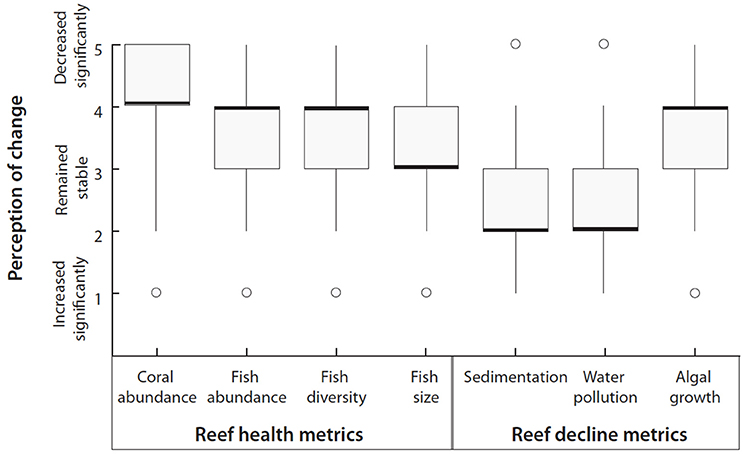
Figure 2. Perceived changes in coral reef ecosystems. Median, quartile, and extreme values for each of the seven metrics of reef health (coral abundance, reef fish abundance, reef fish diversity, reef fish size) and reef degradation (water pollution, sedimentation, and algal growth).
When we group responses into our two binary metrics of perception of change, a majority of respondents reported declines in reef health, with 67% reporting at least one of the four components (coral abundance, fish abundance, fish diversity, fish size) as having decreased significantly or at least two as having decreased, and did not report that any of the four increased. In contrast, only 25% of respondents reported an increase of reef degradation, or at least one of the three components (sedimentation, water pollution, and algal growth) as having increased significantly or at least two as having increased, and did not report that any of the four decreased. This low number is due to the high percentage of respondents reporting a decrease in algal growth.
Willingness to Pay for Reef Conservation
The coefficient estimates for the main effects estimation (Table 2) for increase in coral coverage and biodiversity and the monetary payment attributes is significant in both the CL and MMNL models (Table 2), which demonstrates that respondents value a MPA whose outcome includes increased coral coverage and biodiversity and dislike having to pay. The increase in fish catch attribute had insignificant coefficients in both the CL and the MMNL model. The decrease in coastal development attribute had positive, significant coefficients for respondents in the CL model but not in the MMNL model. The standard deviation of the coefficients of all attributes are statistically significant in the MMNL model (Table 2), which indicates the presence of heterogeneity in preferences1. Because of this, we rely on the MMNL model for conducting the detailed analysis with interaction terms.
Respondents were willing to pay for one of the three predicted benefits of protected areas: increased coral coverage and biodiversity, with annual contributions of US $5.61 for a 10% increase in coral coverage and biodiversity (Table 3). The marginal WTP for the ASC indicates the overall WTP for the proposed protected area, irrespective of levels of the attributes. Respondents had a WTP of US $142.22 annually, highlighting a willingness to support the creation of MPA. We then used the marginal WTP values to calculate the total WTP for a hypothetical protected area that is predicted to result in a 30% increase in fish catch, coral coverage, and biodiversity and a 30% decrease in coastal development. The total WTP for was US $164.12 (95% CI $132.28-$195.96) annually.
Shifted Baselines Affect Willingness to Pay for Conservation
We found evidence that shifted baselines affect WTP for conservation: residents who perceived a decline in reef health were willing to pay more to support protected areas. Specifically, residents who perceived a decline in reef health had a WTP for the hypothetical protected area that was more than double that of residents who perceived no change: US $256.80 vs. US $102.50 (Figure 3). The increase in the WTP is driven by the overall WTP for the protected areas (the ASC term) as opposed to the WTP for individual attributes (see significant terms in Table 4). We also found evidence that shifting baselines affect WTP for one of the individual attributes, coral coverage. The coefficient of the interaction term of coral coverage and “reef health decline” variable was significant and positive (Table 4). This implies that respondents who recognize the decline in reef health have a higher marginal utility from the protected areas that would increase coral coverage than residents who do not recognize the decline.
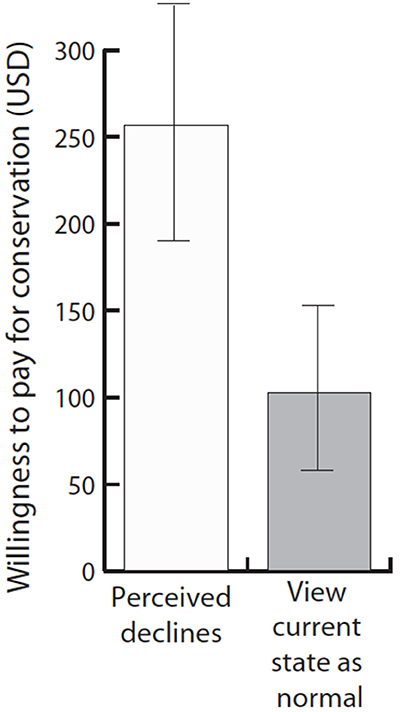
Figure 3. Shifted historical baselines reduce WTP for conservation. Residents who perceived declines in reef health are willing to pay more for a hypothesized coral reef conservation project than are those who view the current state as normal. Values are mean annual WTP for a conservation project predicted to result in a 30% increase in fish catch, a 30% increase in coral coverage, and a 30% decrease in coastal development. Error bars represent 95% confidence intervals.
Discussion
Our results provide empirical evidence that shifting baselines, or failure to perceive past change, affect support for conservation and complement work that shows that perceptions of the current environment or the “status-quo” impact WTP (Meyerhoff and Liebe, 2009; Domínguez-Torreiro and Soliño, 2011; Marsh et al., 2011; Kataria et al., 2012; Artell et al., 2013). Specifically, we find that those who perceive more change in coral reef ecosystems are willing to pay more to protect them. With large and often undocumented changes in both marine and terrestrial ecosystems (Lotze and Worm, 2009; Bonebrake et al., 2010), the implications of our results to conservation planning are substantial; in places with more unrecognized degradation, conservation projects will have less support, whereas goals for ecosystem restoration, protected areas, and species recovery are likely to be more ambitious if the public is aware of long term change. Therefore, it is important that conservation scientists and practitioners continue to document long term change and communicate these changes to the public. Likewise, there is a strong potential for organized citizen science to contribute to these efforts, whereby individuals can collect data to collectively document changes they have observed over their lifetimes (e.g., http://fishtory.co.za/).
Our results also suggest that the public is aware of the specific components of global degradation to coral reef ecosystems. Most respondents correctly identified changes to the major components of reef ecosystems, including declines in coral and fish, and increases in sedimentation and pollution. However, the majority of respondents did not perceive an increase in algae, which is associated with reef degradation. Phase shifts on coral reefs from coral to algal dominated states are key threshold events that are difficult to reverse (Hughes, 1993). Better communication of how algal increases are linked to reef degradation may be key in garnering public support for efforts such as the removal of algae from reefs, the reduction in nutrient pollution helping to drive increases (Smith et al., 2008), or the protection of herbivorous fish that maintain low levels of algae and facilitate coral recovery (Bellwood et al., 2004; Jackson et al., 2014).
Our results demonstrate that shifting baselines can impact WTP, and build on previous work showing the importance of accounting for perceptions and subjective status-quo beliefs when eliciting WTP for ecosystem restoration (Meyerhoff and Liebe, 2009; Domínguez-Torreiro and Soliño, 2011; Marsh et al., 2011; Kataria et al., 2012; Artell et al., 2013). These studies also provide evidence that loss aversion can influence WTP (Neuman and Neuman, 2007; Bateman et al., 2009; Espinosa-Goded et al., 2010; Masiero and Hensher, 2010), which may also be a possible mechanism to help explain our results. That is, for the respondents who perceive losses, a MPA increases their utility toward pre-degradation levels, whereas for respondents who do not perceive losses, an MPA presents a gain in utility. Loss aversion would predict that the changes in utility for the former are greater than changes in utility for the latter for mirrored improvements.
As a whole, our results highlight the importance of considering historical ecosystem change when quantifying the public's value of nature using non-market valuation studies. By excluding respondent's beliefs about past change, preferences and WTP value estimates will be biased, potentially undervaluing ecosystem goods and services. This can in turn influence policy decisions regarding protection and conservation of ecosystem goods and services. By incorporating information on knowledge of past change, researchers will be able to obtain a more detailed understanding of the values for ecosystem goods and elicit more accurate estimates that account for baseline shifts among members of the public.
Finally, our results suggest that communicating environmental problems is important in engaging the public. While communication of hopeful messages is likely also engaging, we show that if people recognize declines, they are more willing to pay for conservation. The conservation community should not shy away from truthful messages that describe the real degradation of ecosystems and decline of species.
Ethics Statement
This study was carried out in accordance with the recommendations of the Institutional Review Board of the Okinawa Institute of Science and Technology with written informed consent from all subjects. All subjects gave written informed consent in accordance with the Declaration of Helsinki. The protocol was approved by the Institutional Review Board of the Okinawa Institute of Science and Technology.
Author Contributions
Data collection: PS and SD; Data analysis, interpretation: SD and RM; Data visualization: LM and SD; Paper writing, paper editing: LM and SD.
Conflict of Interest Statement
The authors declare that the research was conducted in the absence of any commercial or financial relationships that could be construed as a potential conflict of interest.
The reviewer AS and handling Editor declared their shared affiliation.
Acknowledgments
Funding and support for conducting the survey was provided by The Okinawa Institute of Science and Technology Graduate University in Okinawa, Japan. Funding for RM was provided by the Colby College Summer Research Assistant Program at Colby College, Waterville, ME, U.S.A.
Footnotes
1. ^We also analyze the robustness of the main effects MMNL model under different assumptions for the parameter distributions for the cost term including fixed, normal and log-normal.
References
Adamowicz, W., Boxall, P., Williams, M., and Louviere, J. (1998). Stated preference approaches for measuring passive use values: choice experiments and contingent valuation. Am. J. Ag. Econ. 80, 64–75. doi: 10.2307/3180269
Adamowicz, W., Swait, J., Boxall, P., Louviere, J., and Williams, M. (1997). Perceptions versus objective measures of environmental quality in combined revealed and stated preference models of environmental valuation. J. Environ. Econ. Manag. 32, 65–84. doi: 10.1006/jeem.1996.0957
Artell, J., Ahtiainen, H., and Pouta, E. (2013). Subjective vs. objective measures in the valuation of water quality. J. Environ. Manag. 130, 288–296. doi: 10.1016/j.jenvman.2013.09.007
Bateman, I. J., Day, B. H., Jones, A. P., and Jude, S. (2009). Reducing gain–loss asymmetry: a virtual reality choice experiment valuing land use change. J. Environ. Econ. Manage. 58, 106–118. doi: 10.1016/j.jeem.2008.05.003
Bellwood, D. R., Hughes, T. P., Folk, C., and Nystrom, M. (2004). Confronting the coral reef crisis. Nature 429, 827–833. doi: 10.1038/nature02691
Birol, E., Katia, K., and Koundouri, P. (2006). Using a choice experiment to account for preference heterogeneity in wetland attributes: the case of Cheimaditida wetland in Greece. Ecol. Econ. 60, 145–156. doi: 10.1016/j.ecolecon.2006.06.002
Bonebrake, T. C., Christensen, J., Boggs, C. L., and Ehrlich, P. R. (2010). Population decline assessment, historical baselines, and conservation. Cons. Lett. 3, 371–378. doi: 10.1111/j.1755-263X.2010.00139.x
Carlsson, F., Frykblom, P., and Liljenstolpe, C. (2003). Valuing wetland attributes: an application of choice experiments. Ecol. Econ. 47, 95–103. doi: 10.1016/j.ecolecon.2002.09.003
Carson, R. T., and Louviere, J. J. (2011). A common nomenclature for stated preference elicitation approaches. Env. Res. Econ. 49, 539–559. doi: 10.1007/s10640-010-9450-x
Charles, A., and Wilson, L. (2009). Human dimensions of marine protected areas. ICES J. Mar. Sci. 66, 6–15. doi: 10.1093/icesjms/fsn182
Dissanayake, S. T. M., and Ando, A. W. (2014). Valuing Grassland restoration: proximity to substitutes and trade-offs among conservation attributes. Land Econ. 90, 237–259. doi: 10.3368/le.90.2.237
Domínguez-Torreiro, M., and Soliño, M. (2011). Provided and perceived status quo in choice experiments: implications for valuing the outputs of multifunctional rural areas. Ecol. Econ. 70, 2523–2531. doi: 10.1016/j.ecolecon.2011.08.021
Espinosa-Goded, M., Barreiro-Hurlé, J., and Ruto, E. (2010). What do farmers want from agri-environmental scheme design? A choice experiment approach. J. Agric. Econ. 61, 259–273. doi: 10.1111/j.1477-9552.2010.00244.x
Hanley, N., Barbier, E. B., and Barbier, E. (2009). Pricing Nature: Cost-Benefit Analysis and Environmental Policy. Northampton, MA: Edward Elgar Publishing.
Hensher, D. A., and Greene, W. H. (2003). The mixed logit model: the state of practice. Transportation 30, 133–176. doi: 10.1023/A:1022558715350
Hensher, D. A., Rose, J. M., and Greene, W. H. (2005). Applied Choice Analysis: A Primer. Cambridge: Cambridge University Press.
Hoegh-Guldberg, O. (1999). Climage change, coral bleaching, and the future of the world's coral reefs. Mar. Fresh. Res. 50, 839–866. doi: 10.1071/MF99078
Hoegh-Guldberg, O., Mumby, P. J., Hooten, A. J., Steneck, R. S., Greenfield, P., Gomez, E., et al. (2007). Coral reefs under rapid climate change and ocean acidification. Science 318, 1737–1742. doi: 10.1126/science.1152509
Hughes, T. P. (1993). Catastrophies, phase shifts, and large-scale degradation of a Caribbean coral reef. Science 265, 1557–1551.
Jackson, J. B. C., Donovan, M., Cramer, K., and Lam, V. (2014). Status and trends of Caribbean coral reefs: 1970-2012. Washington, DC: Global Coral Reef Monitoring Network.
Jacquet, J., Estes, J., Jackson, J., Johnson, A. E., Knowlton, N., McClenachan, L., et al. (2015). Ocean calamities: hypled litany or legitime concern? Bioscience 65, 745–746. doi: 10.1093/biosci/biv087
Jefferson, R., McKinley, E., Capstick, S., Fletcher, S., Griffin, H., and Milanese, M. (2015). Understanding audiences: making public perceptions research matter to marine conservation. Ocean Coast. Manag. 115, 61–70. doi: 10.1016/j.ocecoaman.2015.06.014
Kataria, M., Bateman, I., Christensen, T., Dubgaard, A., Hasler, B., Hime, S., et al. (2012). Scenario realism and welfare estimates in choice experiments–A non-market valuation study on the European water framework directive. J. Environ. Manage. 94, 25–33. doi: 10.1016/j.jenvman.2011.08.010
Knowlton, N., and Jackson, J. B. C. (2008). Shifting baselines, local impacts, and global change on coral reefs. PLoS Biol. 6:e54. doi: 10.1371/journal.pbio.0060054
Kuhfeld, W. F. (2010). Statistical Graphics in SAS: An Introduction to the Graph Template Language and the Statistical Graphics Procedures. Cary, NC: SAS Institute.
Lotze, H. K., and Worm, B. (2009). Historical baselines for large marine animals. TREE 24, 254–262. doi: 10.1016/j.tree.2008.12.004
Louviere, J. J., Hensher, D. A., and Swait, J. D. (2000). Stated Choice Methods: Analysis and Applications. Cambridge: Cambridge University Press.
Marsh, D., Mkwara, L., and Scarpa, R. (2011). Do respondents' perceptions of the status quo matter in non-market valuation with choice experiments? An application to New Zealand freshwater streams. Sustainability 3, 1593–1615. doi: 10.3390/su3091593
Marshal, N. J., Kleine, D. A., and Dean, A. J. (2012). CoralWatch: education, monitoring, and sustainability through citizen sciene. Front. Ecol. Environ. 10, 332–334. doi: 10.1890/110266
Masiero, L., and Hensher, D. A. (2010). Analyzing loss aversion and diminishing sensitivity in a freight transport stated choice experiment. Transp. Res. A Policy Pract. 44, 349–358. doi: 10.1016/j.tra.2010.03.006
McClenachan, L. (2009). Documenting loss of large trophy fish from the florida keys from historical photographs. Cons. Bio. 23, 636–643. doi: 10.1111/j.1523-1739.2008.01152.x
McClenachan, L., Ferretti, F., and Baum, J. K. (2012). From archives to conservation: why historical data are needed to set baselines for marine animals and ecosystems. Cons. Lett. 5, 349–359. doi: 10.1111/j.1755-263X.2012.00253.x
Meyerhoff, J., and Liebe, U. (2009). Status quo effect in choice experiments: empirical evidence on attitudes and choice task complexity. Land Econ. 85, 515–528. doi: 10.3368/le.85.3.515
Mooney, C. (2017). As Coral Reefs Die, Huge Swaths of the Seafloor Are Deteriorating Along With Them. Washington, DC: The Washington Post.
Munday, P. L. (2004). Habitat loss, resource specialization, and extinction on coral reefs. Glob. Change Biol. 10, 1642–1647. doi: 10.1111/j.1365-2486.2004.00839.x
Neuman, E., and Neuman, S. (2007). Reference-Dependent Preferences and Loss Aversion: A Discrete Choice Experiment in the Health-Care Sector. IZA Discussion Paper Series. Institute for the Study of Labor, Bonn.
Nishihira, M. (1987). Natural and human interference with the coral reef and coastal environments in Okinawa. Galaxea 6, 311–321.
Omori, M. (2011). Degradation and restoration of coral reefs: experience in Okinowa Japan. Mar. Biol. Res. 7, 3–12. doi: 10.1080/17451001003642317
Pauly, D. (1995). Anecdotes and the shifting baseline syndrome of fisheries. TREE 10:430. doi: 10.1016/S0169-5347(00)89171-5
Saenz Arroyo, A., Roberts, C. M., Torre, J., Carino-Olvera, M., and Enriquez-andrade, R. R. (2005). Rapidly shifting environmental baselines among fishers in the Gulf of California. Proc B. 272, 1957–1962. doi: 10.1098/rspb.2005.3175
Smith, J. E., Conklin, E. J., Smith, C. M., and Hunter, C. L. (2008). Fighting algae in Kanhohe bay- response. Science 319, 157–158. doi: 10.1126/science.319.5860.157b
Keywords: baselines, coral reefs, choice experiments, marine conservation, ocean optimism, willingness to pay
Citation: McClenachan L, Matsuura R, Shah P and Dissanayake STM (2018) Shifted Baselines Reduce Willingness to Pay for Conservation. Front. Mar. Sci. 5:48. doi: 10.3389/fmars.2018.00048
Received: 07 August 2017; Accepted: 02 February 2018;
Published: 27 February 2018.
Edited by:
Romuald Lipcius, Virginia Institute of Marine Science, United StatesReviewed by:
Andrew M. Scheld, Virginia Institute of Marine Science, United StatesGeret Sean DePiper, National Oceanic and Atmospheric Administration (NOAA), United States
Copyright © 2018 McClenachan, Matsuura, Shah and Dissanayake. This is an open-access article distributed under the terms of the Creative Commons Attribution License (CC BY). The use, distribution or reproduction in other forums is permitted, provided the original author(s) and the copyright owner are credited and that the original publication in this journal is cited, in accordance with accepted academic practice. No use, distribution or reproduction is permitted which does not comply with these terms.
*Correspondence: Loren McClenachan, bGVtY2NsZUBjb2xieS5lZHU=
 Loren McClenachan
Loren McClenachan Ryunosuke Matsuura2
Ryunosuke Matsuura2 Payal Shah
Payal Shah Sahan T. M. Dissanayake
Sahan T. M. Dissanayake